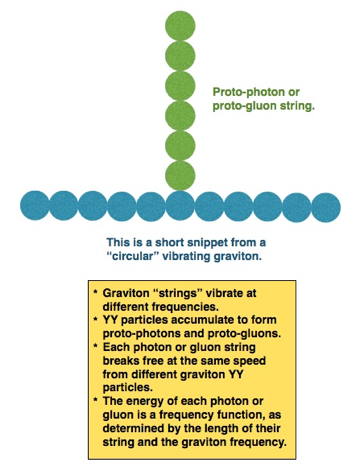It is generally envisioned that the hypothesized gravitons, at likely 10^-37 meters and well within the Planck dimension of 10^-35 meters, are the smallest "particles." Even though this size is incredibly small, and close to where energy and matter blur, there is one smaller particulate dimension at approximately 10^-40 m.
Both gravitons and bosons in string theory are not considered to be points, but vibrating strings. Gravitons are considered to be strings in the form of small vibrating loops. The question is how do we get 3D lines and loops, rather than 2D lines and loops, inside the Planck dimension?
Both photons and gluons are similar in size, mass, and charge to gravitons. We can consider them to be related as a family, not coincidentally related. The more massive weak force particles are composed of gravitons, from which come their electrodynamic force.
Any good physical theory will need to account for the Law of Conservation of Energy, equally expressed as the Law of Conservation of Energy and Matter. In physics, energy and matter are the same and interchangeable. The formula E = mc^2 expresses this dualism. In that light, anything at the smallest level of existence would tend to be both matter and energy at the same time, or separate but equal in a quantum way. For force carrier particles or strings to do their job they need to be BOTH intact AND interactive. This logically requires components within these bosons that are at the edge of pure energy/mass. When I say "at the edge," I mean spherical particles that retain their mass identity, and simultaneously exhibit energy exchanges.
When we think of electromagnetism, we think of positive and negative charges. However, there is a primary form of EM which relies on very proximate flows between these smallest particles (named below), which provides attraction without the plus and minus charges. This primary force is found inside atoms with gluons zipping around and keeping protons together. It also works similarly in keeping linear and circular strings intact. I call this force "primary EM." The ordinary electromagnetic plus/minus force is "secondary EM." Both force versions are proportionate to Coulomb's Law.
Unlike fermions, bosons do not obey the Pauli exclusion principle, and therefore can occupy dimensions smaller and denser. Electrons are leptons and fermions with a negative charge. Quarks and baryons are also fermions obeying the Pauli exclusion principle, which says no more than one particle of this type can occupy a single quantum state.
Bosons can express primary EM as well as secondary EM; whereas Quarks and Baryons will exhibit secondary electromagnetism. An interesting aspect of the smallest particle not expressing bipolarity is its ability to have more than two directions of energy exchange at the same time.
We can think of strings and circular strings as being like a string of plastic snap beads constituting a child's necklace. If you "step away" far enough these beads look like a continuous string. Even though their string may appear at distance smoothly linear, each tiny "bead" in the string is spherical and functionally separate. Nevertheless, a string of connected primary particles can act as if they are linear when they vibrate and interact with other primary and secondary particles.
The name for these individual primary particles will be YY particles. (They are not to be confused with "Peptide YY shRNA (m) Lentiviral Particles," although of course there are a myriad of primary YY particles inside each of these lentiviral particles, as there are in all other larger particles. Nor are these YY particles named for local Cartesian coordinates X, Y, and Z.)
The "YY" is shorthand for YinYang. We know the Yin and Yang as forming a 2,500-years-old symbol famous in oriental philosophy. The Yang represents light and energy, and the Yin represents dark and matter. These two are pictured inside an iconic circle, with each one growing to a maximum, only to be followed by the other. You can go around this circle as many times as you wish, and the interpenetrating pattern will persist. In classical icon illustrations there is some Yin at the center of each Yang's maximum, and likewise when some Yang persists at the Yin's maximum. Constant motion is the perpetual unity and interpenetration of opposites.
Here below we have modeled a snippet of a graviton circular "string." The graviton's YY particles are arbitrarily depicted here in blue. There is also a modeled, attached snippet of a linear proto-photon, or proto-gluon, arbitrarily shown in green.

The "circular" graviton's interconnected YY particles are each twice held together by primary electromagnetism, not by the force of shadow gravity which terminates at the graviton scale.
Each YY particle is held twice within the photon or gluon, except for the first and last of each such string. The proto-photons and proto-gluons are similarly held only once to the graviton string, giving the proximal YY particle two attachments. The point of attachment to the graviton itself is at a singular graviton YY particle, so that only one YY particle is singularly attached, namely the distal YY particle of the proto-photon.
When photons are released, it is not a random thing. Since the "primary EM" particle-to-particle connective forces are equal all around on this level, their separation is dependent on the vibrational frequency of the connected graviton at the point where the two adjacent YY particles of graviton and attached linear string adhere.
Before releasing, the attached, proximal YY particle of the string stretches/deforms from the jerking, vibrational, centrifugal forces. It stretches from the natural spherical to oblong. To a lesser degree the other YY particles in the attached chain also elongate. At the point of release the temporarily oblong particles simultaneously snap away at "c" speed, resuming their natural spherical shapes in a near-zero time (the spherical shape being determined by their internal primary EM). The new photon thus travels away at quantum "light speed," which is the time/distance it takes for the proximal YY particles to resume their natural spherical shape. Particulate strings escape initially at "light speed," allowing for the illusion that "c" is some sort of exogenous speed limit within inertial frames.
Up until the connected graviton YY particle vibrates too fast for the proximal YY particle to continue holding, the string of YY particles constituting what will become a proton or gluon whips back and forth. The distal proto-string YY particle vibrates at a less energetic frequency at and before the separation, so it remains attached to its string, even with one connection, while the proximal YY particle breaks free. At the point of breaking loose, the photon or gluon has its given frequency and mass/energy.
Photons have the same primary EM attraction to their graviton YY particle, and are all released at the speed of "c". Their post-release wave energy depends on their vibrational frequency, which is a function of the length of their string when set free. Shorter photon strings vibrate at higher frequencies than longer photon strings. It takes a higher graviton frequency to kick loose short attached strings, versus long strings with greater inertial mass, thus yielding different EM energies within the freed strings. Spectroscopic and wave-length characteristics can thereby greatly differ.
The act of breaking free lowers the energy of the host graviton to the degree that the new photon or gluon has been given vibrational energy. This transfer preserves the overall conservation of energy.
When free incoming gravitons "push" into nucleons, according to push gravity, they transfer kinetic energy to the nucleons and to their constituent bound gravitons. If the energy accretion were to continue even briefly without remediation, there would be the catastrophy that Henri Poincare saw with the original Le Sage concept. In this corrected dynamic and homeostatic model there is no general instant annihilation. The Law of Conservation of Energy is respected, balancing out the kinetic and potential energies. Gravity works properly, and "weakened" gravitons, having bumped into nucleons, often fly off and join the local Dark Matter cloud. Some gravitons join other gravitons inside the nucleon as part of the equilibrium machine.
Meanwhile, photons in multiple, quantum-discrete varieties are liberated, and gluons are sent forth to corral mutually repelling protons. All this energy exchanging at the very smallest levels enables ordinary matter to accumulate and dialectically diversify as atoms and molecules, leading to our complex everyday world.
There is a historical story to tell from within this energy level: As vast amounts of energy cascaded in on our pre-Big-Bang core, gravitons were increasingly squeezed together, but not to a pure singularity. They translated the push kinetics into increased vibrational frequencies, causing a quantum push-back. All of this energy needed to be released, and what happened was our current Big Bang explosion. What happened was a vastly more powerful version of man-made implosion nuclear bombs. What pushed back was not a bunch of intact gravitons, but fragmented gravitons, as the increased frequencies under extreme pressure broke graviton YY bonds. Since a YY particle is a YY particle, those new fragment strings expressed themselves as super-high-frequency photons of nearly pure energy, allowing for the initial period of inflation. The length of these Big Bang photon strings was shorter than photon strings yielding X-ray energy, but longer than photon strings that would implode into their own black holes. The rest is our history.


